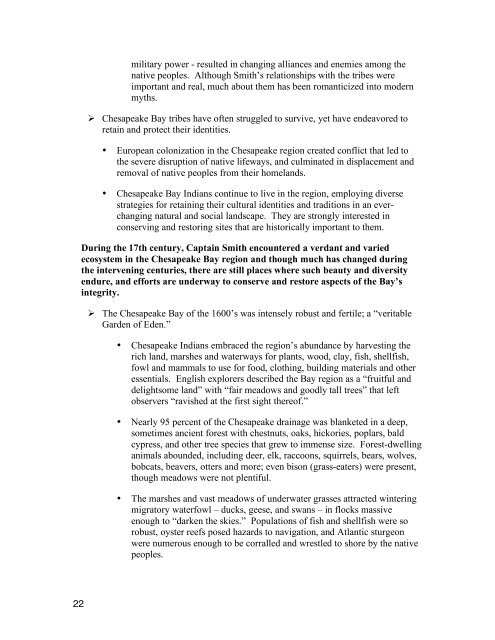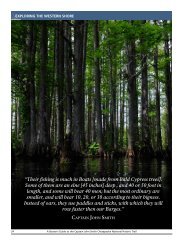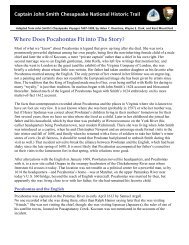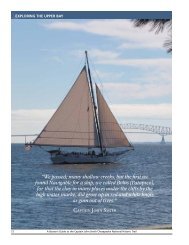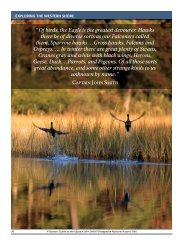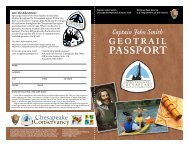Draft Interpretive Plan Join the adventure! - Captain John Smith ...
Draft Interpretive Plan Join the adventure! - Captain John Smith ...
Draft Interpretive Plan Join the adventure! - Captain John Smith ...
You also want an ePaper? Increase the reach of your titles
YUMPU automatically turns print PDFs into web optimized ePapers that Google loves.
military power - resulted in changing alliances and enemies among <strong>the</strong><br />
native peoples. Although <strong>Smith</strong>’s relationships with <strong>the</strong> tribes were<br />
important and real, much about <strong>the</strong>m has been romanticized into modern<br />
myths.<br />
Chesapeake Bay tribes have often struggled to survive, yet have endeavored to<br />
retain and protect <strong>the</strong>ir identities.<br />
• European colonization in <strong>the</strong> Chesapeake region created conflict that led to<br />
<strong>the</strong> severe disruption of native lifeways, and culminated in displacement and<br />
removal of native peoples from <strong>the</strong>ir homelands.<br />
• Chesapeake Bay Indians continue to live in <strong>the</strong> region, employing diverse<br />
strategies for retaining <strong>the</strong>ir cultural identities and traditions in an everchanging<br />
natural and social landscape. They are strongly interested in<br />
conserving and restoring sites that are historically important to <strong>the</strong>m.<br />
During <strong>the</strong> 17th century, <strong>Captain</strong> <strong>Smith</strong> encountered a verdant and varied<br />
ecosystem in <strong>the</strong> Chesapeake Bay region and though much has changed during<br />
<strong>the</strong> intervening centuries, <strong>the</strong>re are still places where such beauty and diversity<br />
endure, and efforts are underway to conserve and restore aspects of <strong>the</strong> Bay’s<br />
integrity.<br />
The Chesapeake Bay of <strong>the</strong> 1600’s was intensely robust and fertile; a “veritable<br />
Garden of Eden.”<br />
• Chesapeake Indians embraced <strong>the</strong> region’s abundance by harvesting <strong>the</strong><br />
rich land, marshes and waterways for plants, wood, clay, fish, shellfish,<br />
fowl and mammals to use for food, clothing, building materials and o<strong>the</strong>r<br />
essentials. English explorers described <strong>the</strong> Bay region as a “fruitful and<br />
delightsome land” with “fair meadows and goodly tall trees” that left<br />
observers “ravished at <strong>the</strong> first sight <strong>the</strong>reof.”<br />
• Nearly 95 percent of <strong>the</strong> Chesapeake drainage was blanketed in a deep,<br />
sometimes ancient forest with chestnuts, oaks, hickories, poplars, bald<br />
cypress, and o<strong>the</strong>r tree species that grew to immense size. Forest-dwelling<br />
animals abounded, including deer, elk, raccoons, squirrels, bears, wolves,<br />
bobcats, beavers, otters and more; even bison (grass-eaters) were present,<br />
though meadows were not plentiful.<br />
• The marshes and vast meadows of underwater grasses attracted wintering<br />
migratory waterfowl – ducks, geese, and swans – in flocks massive<br />
enough to “darken <strong>the</strong> skies.” Populations of fish and shellfish were so<br />
robust, oyster reefs posed hazards to navigation, and Atlantic sturgeon<br />
were numerous enough to be corralled and wrestled to shore by <strong>the</strong> native<br />
peoples.<br />
22


